
In September 2022 Oxbow's bookshop and distribution buisness merged with Pen & Sword Books, a family run independent publisher of history books. The book distribution aspect of our business will continue to bring you some of the best books in the field of archaeology and related disciplines as Casemate UK. The Oxbow Books publishing imprint remains as a separate entity, still sold and distributed exclusively by us.
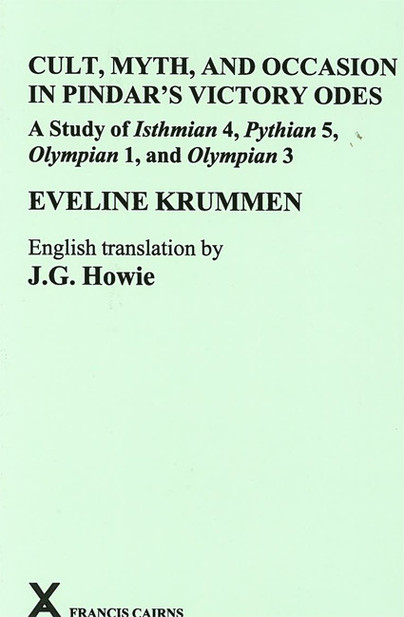
Format: Hardback
Pages: 356
ISBN: 9780905205564
Pub Date: 26 May 2014
Imprint: Francis Cairns Publications
Description:
In this pioneering study, first published in German as Pyrsos Hymnon. Festliche Gegenwart und mythisch-rituelle Tradition als Voraussetzung einer Pindarinterpretation (Isthmie 4, Pythie 5, Olympie 1 und 3) (1990), Eveline Krummen examines the related problems of the unity (or intelligibility and cohesion) and the ‘occasionality’ (the heuristic importance of the original performance situation) of Pindaric epinicia. She uses various approaches - including narratology, archaeology, and art history, as well as philology - to recover information about original performance occasions and original audience expectations, and thus to come to a clearer understanding of the structure and strategies of this sometimes baffing poetry.
Throughout the book she focuses primarily on the interactions between myths and cult festivals, and on Pindar’s skill in integrating and innovating upon traditional material. An introductory chapter discusses ‘occasionality’ and surveys scholarly views of the unity of Pindaric victory odes in general. The four main chapters deal in turn with each of the Odes selected as ‘case-studies’. These all contain a passage referring to a cult festival. In Isthmian 4 and Pythian 5 the reference is explicit, and to a festival currently being celebrated: in Olympian 1 reference is made to a festival celebrated earlier at the place of victory, and in Olympian 3 the reference is again arguably to a festival still in progress. Krummen delineates the historical settings of the cults and their related festivals, and each chapter ends with a consideration of how the cult passage fits into the poem as a whole. Brief appendixes list Pindaric allusions to festivals and cults are listed, and give sketch maps of the topography of Thebes and of Cyrene. A bibliography and indexes are included. Study of the cult passages naturally includes study of their related myths. Adopting the approach of modern researchers in religious history, Krummen details the basic patterns, the ‘programmes of actions’ underlying Pindar’s mythical and ritual narratives, patterns fixed in the cultures of the communities concerned. On this basis she shows, for example, that Pindar’s treatment of the myth of Pelops in Olympian 1 goes beyond mere rationalisation; rather he alters its role within the audience’s cultural expectations, in a way that makes his revision not only convincing but also profoundly acceptable. Modern approaches to Greek lyric narrative enable Krummen to clarify sequences of events in Pindar’s foundation myth of Cyrene in Pythian 5, and archaeology guides her to the true role of his topographical allusions within his narrative. Comparison with rituals in other parts of Greece helps to explicate the text in both Olympian 3 and Isthmian 4, and Weinrich’s theory of metaphor, in combination with archaeology, enables Krummen to identify the ‘new-built crownings of altars’ in Isthmian 4 and to reveal their full significance. Finally Krummen’s view of the original occasions and the myths of these odes makes full use of surviving works of art. Throughout, the Greek text is kept firmly in sight: for instance, her meticulous discussion of text, grammar, and tense provides a sound basis for a convincing identification of the Antenorids in Pythian 5 and for the reconstruction of their role in the Carnea in Cyrene. Finally, Krummen reveals how in all four odes the cult passages contribute at literal, figurative, and associative levels to the praise of the patron. In that sense Krummen brings us closer to grasping the unity of these poems. Cult, Myth, and Occasion in Pindar’s Victory Odes has already proved influential in its original German form. J.G. Howie’s English translation will make it widely accessible to students and scholars throughout the English-speaking world. The author. Eveline Krummen has pursued the study of Classical Philology at the Universities of Bern, Zürich, Cambridge, and Tübingen, and she taught as an adjunct at the Universities of Bern and Zürich, occasionally standing in for Professor Most at the University of Heidelberg. At Zürich she was licensed in 1987 with a dissertation later published (1990) as Pyrsos Hymnon. Festliche Gegenwart und mythisch-rituelle Tradition als Voraussetzung einer Pindarinterpretation (Isthmie 4, Pythie 5, Olympie 1 und 3). She was habilitated at Zürich in 1997, with a two-part thesis: a monograph on the early Greek lyric in its cultural context; and a text and commentary of Jacoby;s FGrHist Teil IV fasc. 2 on ancient historical writings. In 1999 she was appointed to her present position as Professor of Classical Philology at the University of Graz, Austria. Her research interests are in early Greek literature, Greek historiography, and Greek religion, and she has contributed in these fields to a number of periodicals, collected papers, and encyclopaedias. The Translator. J. Gordon Howie studied at the Universities of Glasgow and Oxford (Balliol College), and taught in the Department of Greek (later Classics) at the University of Edinburgh, where he was Senior Lecturer in Classics and is currently an Honorary Research Fellow. He is a Member of the Institute of Translation and Interpreting. In addition to his own scholarly articles on early Greek literature, now collected in Exemplum and Myth, Criticism and Creation (2012), his translation of Detlev Fehling’s Die Quellenangaben bei Herodot, on which he worked closely with the author to produce a definitive version, Herotodus and his ‘Sources’ (1989), is widely known and appreciated. He has also collaborated with Douglas Cairns on the translations in that scholar’s Bacchylides. Five epinician Odes (2010).
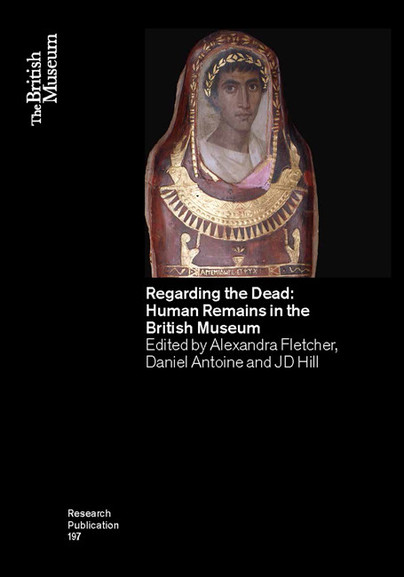
Format: Paperback
Pages: 180
ISBN: 9780861591978
Pub Date: 26 May 2014
Series: British Museum Research Publications
Illustrations: 80 illustrations
Description:
The British Museum holds approximately 6,000 human remains, the majority of which were recovered in the past century. Regarding the Dead addresses the British Museum’s approach to the ethical issues surrounding the inclusion of human remains in the Museum’s collection and presents solutions to the dilemmas relating to their curation, storage, access management and display. The holding of human remains in museums has long been a matter of academic and public discourse.
The issues surrounding the rightful ownership, proper care, research and display of human remains are strongly debated, both within the museums and heritage sector and in the media on an international scale. Using case studies from the British Museum, Regarding the Dead examines these issues and explains how the availability of human remains for study has many benefits. Human remains provide the most direct and insightful sources of information on different cultural approaches to death, burial practices and belief systems. Their study also helps to advance important research concerning the history of disease, changing epidemiological patterns, forensics and human biology. The book draws together diverse strands of research concerning human remains and reflects the great variety of challenges and discoveries associated with this work as well as the sensitivities involved.
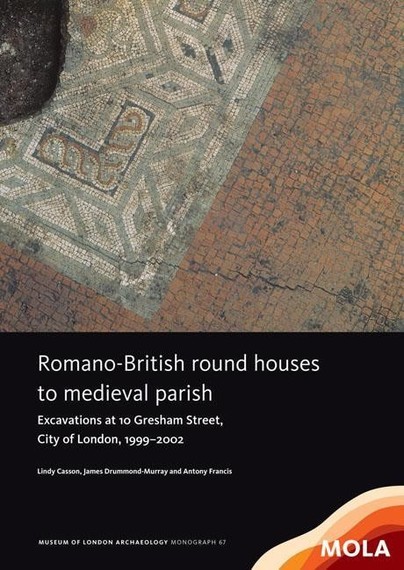
Format: Hardback
Pages: 250
ISBN: 9781907586224
Pub Date: 30 Apr 2014
Series: MoLAS Monograph
Illustrations: Fully colour illustrated
Description:
Good preservation in the western part of 10 Gresham Street has led to an unusually complete picture of the archaeological sequence.The discovery here of the largest group of Romano-British round houses yet excavated in London, clustered round a rectangular building, is of considerable significance for the Iron Age–Roman transition. Moreover, the site’s main north–south road seems to have been key to determining the layout of this whole area while evidence pointing to sporadic fires in the 2nd century AD casts new light on the idea of a single, catastrophic event.
Significant finds include a double gold finger ring of the 1st century AD, while close study of face pots and tazze leads to a rethinking of their possible ritual functions.Abandoned from the late 4th/early 5th century AD until the 10th century, by the 12th century the site boasted at least four masonry buildings. The remains of several rare and expensive glass display vessels found in a 13th-century refuse pit indicate the presence of an extremely affluent household. Later, two taverns stood on the site or very close by, and significant numbers of vessels for storing and serving ale and wine were recovered. Considerable truncation of post-medieval structures and deposits, however, means that only the deepest cellars and cesspits survived from that period.

Format: Paperback
Pages: 441
ISBN: 9780956305497
Pub Date: 30 Apr 2014
Imprint: Pre-Construct Archaeology
Description:
The unremarkable arable landscape around Mount Pleasant today belies the importance of the area in the past; at the highest point of the Lincolnshire Wolds and at the head of three radial valleys, this was a highly significant locality in earlier times. The discovery of surface finds by archaeologists working ahead of a prospective gas pipeline in 1992-3 augmented a collection of finds metal-detected during the 1980s. The large number of Iron Age coins and contemporary miniatures indicative of votive material suggested the location of a shrine.
At the instigation of the County Archaeologist supported by Lincolnshire County Council, Steven Willis began a programme of evaluation trenching at Mount Pleasant in 1998 in a research exercise designed to better understand the site and to assemble information to assist the longer term management of the extensive, though fragile, remains there. The work on site included student training in fieldwork methods, assisted by the vital contribution of volunteers from the local community.Ten trenches were excavated, each revealing remains confirming the significance of the site to the early populations of the Wolds. A number of Neolithic palisade features were recorded representing land division and enclosure features, evidently part of a ceremonial landscape associated with barrows. The discovery of a stratified Early Bronze Age axe-head, Middle and Late Iron Age finds, including pottery, brooches, quernstones and coins were a testament to its continued occupation.Whilst the more striking finds point to votive activity, evidence for economic and cultural activity and prolific pottery finds from the Early Roman era, suggest a settled community was established by this period. The enclosure systems and tracks revealed by geophysical survey on either side of the B1225, which runs through the site, suggested that the modern road must overly a Roman predecessor. Stone founded buildings and site morphology exposed by excavation confirmed this and showed the site to have been a nodal point in the landscape, a crossroads embedded in the topography. A continuing religious focus at the site is demonstrated by the presence of an inscribed lead tablet of the Late Roman period with a list of named Roman citizens, presumably two households of this site or locality.Studies of faunal and environmental samples provide an insight into diet, crop production, local ecology and land use. Together with the specialist analysis of the artefactual evidence, this volume reveals a complex picture of the life and times of the site until occupation came to a rather abrupt end in the first half of the fourth century in an apparently widespread re-organization of settlement in the region. There was no post-Roman occupation; until the recent discoveries, all evidence of the rich archaeology of the site was in danger of remaining in obscurity. Further investigative work on the Wolds however is now recognized as a research priority.
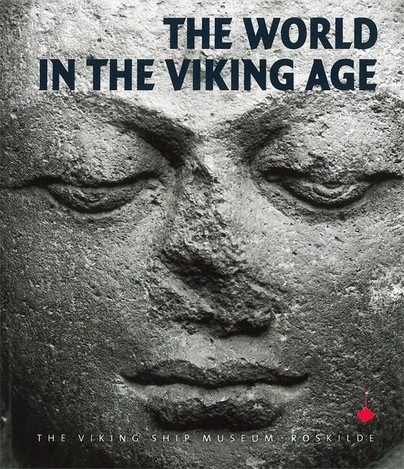
Format: Paperback
Pages: 140
ISBN: 9788785180704
Pub Date: 28 Apr 2014
Description:
The Viking Age was ignited by the art of building seaworthy sailing ships and the skills to sail them on the open sea. The growth in seafaring, trade, piracy, and exploration that began to gather momentum during the 8th century CE was not limited to Europe’s northern seas, however. Ships, laden with cargo and with seafarers who met foreign cultures, created unexpected connections between people from the Arctic Circle to the oceans south of the equator.
Travel accounts have handed down glimpses of these voyages to the present day. However, it is archaeological discoveries in particular which uncover the story of Viking-Age seafaring and voyages of exploration. The World in the Viking Age reveals a global history concerning ships, people and objects on the move. It is a story that challenges entrenched ideas about the past and present, and the skills and opportunities of previous generations.

Format: Paperback
Pages: 120
ISBN: 9781782972150
Pub Date: 23 Apr 2014
Illustrations: b/w and col. illustrations
Description:
The analysis of silk is a fascinating topic for research in itself but here, focusing on the 9th and 10th centuries, Marianne Vedeler takes a closer look at the trade routes and the organization of production, trade and consumption of silk during the Viking Age. Beginning with a presentation of the silk finds in the Oseberg burial, the richest Viking burial find ever discovered, the other silk finds from high status graves in Scandinavia are discussed along with an introduction to the techniques used to produce raw silk and fabrics. Later chapters concentrate on trade and exchange, considering the role of silk items both as trade objects and precious gifts, and in the light of coin finds.
The main trade routes of silk to Scandinavia along the Russian rivers, and comparable Russian finds are described and the production and regulation of silk in Persia, early Islamic production areas and the Byzantine Empire discussed. The final chapter considers silk as a social actor in various contexts in Viking societies compared to the Christian west.
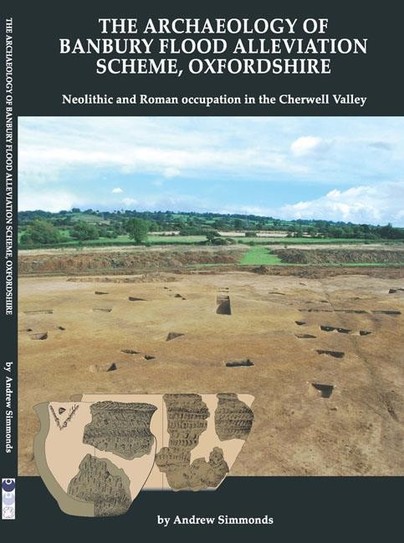
Format: Paperback
ISBN: 9780904220742
Pub Date: 23 Apr 2014
Series: Oxford Archaeology Monograph
Description:
This volume presents the results of investigations undertaken by Oxford Archaeology between 2003 and 2011 in advance of construction of the Banbury Flood Alleviation Scheme, Oxfordshire. The main element of these investigations was an excavation at the site of a borrow pit for clay to be used in constructing the flood defences. Geophysical surveys of two other areas that revealed dense concentrations of buried archaeological remains not subsequently affected by the scheme are also reported.
The excavation uncovered a multi-period landscape containing a regionally significant Neolithic occupation site, as well as later features. The Neolithic remains comprised 35 pits that produced large assemblages of flint and pottery, mainly Peterborough Ware of middle Neolithic date (associated with radiocarbon dates of c 3350-2650 BC). A single substantial but enigmatic middle Bronze Age ditch contained few finds, but these included a radius from an aurochs, one of the latest examples of this species in Britain.Late pre-Roman Iron Age occupation was represented by an oval double-ditched enclosure which, following a brief hiatus, was succeeded toward the end of the 1st century AD by a more extensive low-status farmstead. The settlement was redeveloped during the 2nd century before finally being abandoned in the early-mid 3rd century. Artefactual and palaeoenvironmental assemblages, as well as the spatial arrangement of the settlement, provided evidence regarding the economy, status and social organisation of the community. The volume includes a consideration of the results of the project in the context of Iron Age and Roman settlement of the Cherwell Valley.

Format: Hardback
Pages: 672
ISBN: 9781782972198
Pub Date: 16 Apr 2014
Description:
The eruption of the Thera (Santorini) volcano in the Aegean Sea in the mid-second millennium BC was a clearly defined, specific moment in Aegean and east Mediterranean prehistory that impacted on all the major cultures of the region. The effects of the eruption have been linked with the destruction of the Minoan palace civilisation of Crete, the legend of Atlantis, and even events described in the Biblical account of the Exodus. Scientists have studied the remains of the volcano and traced eruption products and far-flung climatic impacts throughout the east Mediterranean and in ice cores and tree-ring data.
At Akrotiri, a major prehistoric town buried by the eruption, archaeologists unearthed the partially intact remains multi-storey buildings, painted frescoes and myriad objects of everyday life. The date of the eruption has long been a subject of importance and controversy since accurate dating would offer a unique linchpin for the study and synchronisation of the history and cultures of the region in the mid-second millennium. It would provide a key test both for the established historical chronology of ancient Egypt and derived archaeological chronologies. Yet the exact date remained stubbornly unresolved and varied in the literature by over 100 years.A Test of Time, first published in 1999, sought to resolve the issue through a critical review of the archaeological and scientific data, including the presentation of radiocarbon dates, which together suggested a new ‘early’ chronology for the Aegean c. 1700–1400 BC. This edition comprises the original, unrevised text, together with a substantial new appended essay which critically reviews the continuing debate between 1999 and 2012 and presents a raft of new scientific data, including the Bayesian modelling of radiocarbon dates relating to a range of relevant archaeological sequences from Egypt and the eastern Mediterranean.
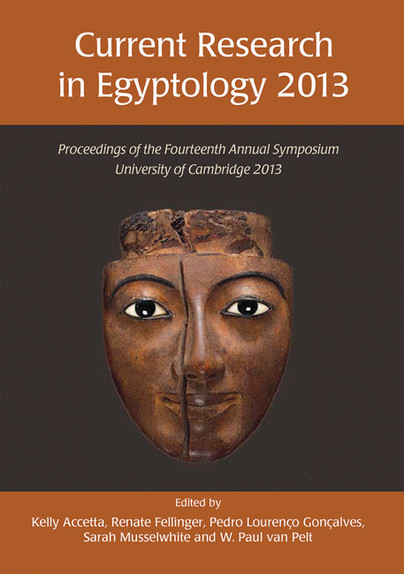
Format: Paperback
Pages: 232
ISBN: 9781782976868
Pub Date: 07 Apr 2014
Series: Current Research in Egyptology
Illustrations: b/w images
Description:
The fourteenth Current Research in Egyptology conference, held at the University of Cambridge in March 2013 brought together speakers and attendees from six continents and hosted more than 50 presentations covering multiple aspects of Egyptology and its related fields. The aim of the conference was to cross cultural and disciplinary boundaries. The papers presented in these proceedings reflect this aim by presenting current research that draws on insights derived from anthropology, archaeology, archaeobotany, ethnography, organic chemistry, geography, linguistics, and law, amongst others.

Format: Paperback
Pages: 152
ISBN: 9781909990005
Pub Date: 01 Apr 2014
Series: Scottish Burgh Survey
Description:
Situated in what now seems a remote corner of south-west Scotland, Wigtown was once an important county town. With its harbour and location at the lowest fording point of the River Cree, Wigtown was at one time part of a major network of land and sea routes, including a pilgrim route to Whithorn. The layout of the town is notable for its large market square, a reflection of its importance in the cattle trade in the medieval period.
The town achieved burgh status in the thirteenth century, by which time it was an important trading centre, and the present arrangement of streets and burgage plots dates to this time. Today the principal access route is from the north, rather than through the East and West Ports which controlled access to the great market place. The burgh arms depict a three-masted sailing ship, demonstrating the importance placed on its maritime trade. This book examines both the town’s political history, as it passed between the earldoms of Wigtown and Douglas, and its economic history, as it competed with Whithorn, before its eventual decline in the later nineteenth century. The authors use the surviving buildings to examine the development of the town from the medieval to the modern period. This book is part of the Scottish Burgh Survey – a series funded by Historic Scotland designed to identify the archaeological potential of Scotland’s historic towns.

Format: Hardback
Pages: 300
ISBN: 9788392591979
Pub Date: 01 Apr 2014
Imprint: Journal of Juristic Papyrology
Series: JJP Supplements
Description:
This work presents the newest trends appearing in the field of Roman Law particularly devoted to the fault-based liability – culpa – that were addressed at the International Conference organised by the Faculty of Law and Administration of Warsaw University in February 2010. Articles written by Merola, Rampazzo and Tucillo touch the problem of culpa in the public law. The authors concentrated on the question of liability of public officers and their culpa or negligence during the performance of their duties.
The social scope of culpa as the prerequisite for a censorial note has been presented by Tarwacka. Adamo addressed some important aspect of fault-related liability in criminal law dealing with the regulations of Theodosian Code. Private law side fault based-liability in contracts was presented by Benincasa and Kordasiewicz. They both analysed contracts used in maritime trade, the former regarding armature’s partnership, the latter in the aspect of the transition from objective liability to the liability based on fault in the case of guarantee for the goods admitted by the sailor. Manni and Święcicka devoted their studies to the delictual liability based on culpa. Finally, Alonso and Urbanik attempted to present culpa-liability in the light of papyrological sources, confronting Roman Law sources and documents of legal practice. These studies provide a wealth of information on the law of antiquity in the subject of liability based on fault, both in the aspect of private and public law.

Format: Hardback
Pages: 264
ISBN: 9781782972532
Pub Date: 31 Mar 2014
Illustrations: b/w and colour illustrations
Description:
Lindsay Allason-Jones has been at the forefront of small finds and Roman frontier research for 40 years in a career focussed on, but not exclusive to, the north of Britain, encompassing an enormous range of object types and subject areas. Divided into thematic sections the contributions presented here to celebrate her many achievements all represent at least one aspect of Lindsay’s research interests. These encompass social and industrial aspects of northern frontier forts; new insights into inscribed and sculptural stones specific to military communities; religious, cultural and economic connotations of Roman armour finds; the economic and ideological penetration of romanitas in the frontiers as reflected by individual objects and classes of finds; evidence of trans-frontier interactions and invisible people; the role of John Clayton in the exploration and preservation of Hadrian’s Wall and its material culture; the detailed consideration of individual objects of significant interest; and a discussion of the widespread occurrence of mice in Roman art.
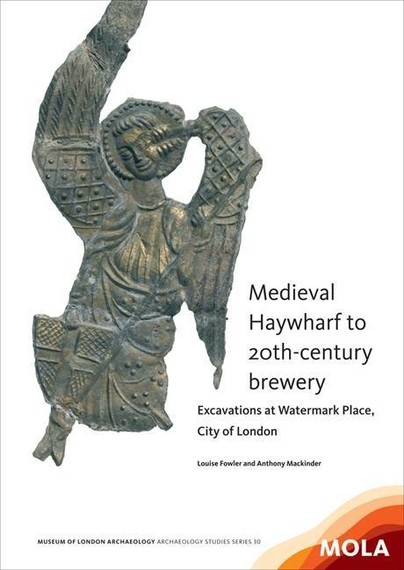
Format: Paperback
Pages: 150
ISBN: 9781907586231
Pub Date: 31 Mar 2014
Illustrations: Fully colour illustrated
Description:
Archaeological excavation by MOLA at Watermark Place in the City of London revealed evidence for the development of the city waterfront from the 13th century onwards. The remains of substantial and well-preserved timber river walls and timber/stone dock walls were recorded, and the use of tree-ring dating enabled the construction of one large timber river wall and dock to be dated to the year 1339. Many of the recorded structures related to the medieval wharf known as the Haywharf, probably originally so-named because it was where hay was imported into the city before c 1300.
In common with other excavations of medieval waterfronts in the City, the waterlogged deposits associated with the structural remains produced a remarkable array of finds, including over 700 accessioned finds. Large medieval foundations on the site probably relate to the mansion known as Coldharbour, which was constructed on the site by the early 14th century. Later remains included a sequence of 15th- to 16th-century industrial stone hearths or furnaces, and documentary evidence suggests that it is likely these were associated with either brewing or dyeing on the site. Also recorded were structures associated with the Calvert’s/City of London brewery, which stood on the site from the 18th century until it was bombed during World War II.
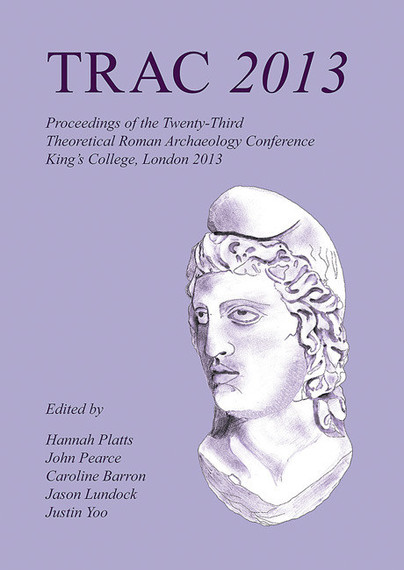
Format: Paperback
Pages: 160
ISBN: 9781782976905
Pub Date: 31 Mar 2014
Series: TRAC
Illustrations: b/w illus
Description:
The twenty-third Theoretical Roman Archaeology Conference (TRAC) was held at King’s College, London in spring 2013. During the three-day conference nearly papers were delivered, discussing issues from a wide range of geographical regions of the Roman Empire, and applying various theoretical and methodological approaches. Sessions included those looking at Roman–Barbarian interactions; identity and funerary monuments in ancient Italy; migration and social identity in the Roman Near East; theoretical approaches to Roman small finds; formation processes of in-fills in urban sites; and new reflections on Roman glass.
This volume contains a selection of papers from the conference sessions.
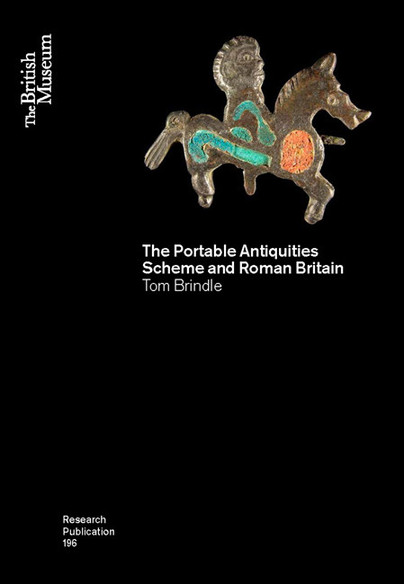
Format: Paperback
Pages: 206
ISBN: 9780861591961
Pub Date: 30 Mar 2014
Series: British Museum Research Publications
Illustrations: 70 maps
Description:
A comprehensive evaluation of the Portable Antiquities Scheme and the archaeological value of its findings particularly in relation to Roman Britain.
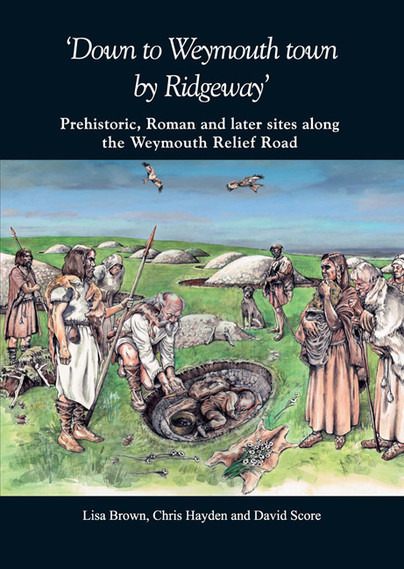
Format: Paperback
Pages: 303
ISBN: 9780900341595
Pub Date: 24 Mar 2014
Description:
The Weymouth Relief Road crosses an area of intricately varied geology and one of the richest and most important cultural landscapes in England, which preserves a wealth of archaeological and historical remains. Extensive fieldwork in advance of construction of the Weymouth Relief Road yielded evidence of Neolithic, Bronze Age and Iron Age settlement and funerary activity, along with vestiges of Roman occupation.The main sites were located at Ridgeway Hill, located on the edge of South Dorset Ridgeway, at the northern end of the scheme and at Southdown Ridge close to the southern end.
At Ridgeway Hill a sequence of Neoltihic pits was investigated, along with several groups of early Bronze Age inhumation and cremation burials in pits and cists. The burials were probably originally associated with barrows that belonged to the Ridgeway Hill group, one of the densest concentrations of Bronze Age round barrows in Britain. At Southdown Ridge a settlement that spanned the late Bronze Age/early Iron Age to the late Iron Age was discovered lying adjacent to a cross-ridge dyke and prehistoric field enclosures. The inhabitants engaged in shale-working activity as well as agriculture until the settlement was abandoned and converted to a cemetery in which the dead were buried in the distinctive south Dorset tradition, accompanied by grave goods, and later in the Roman tradition of coffined burial.

















